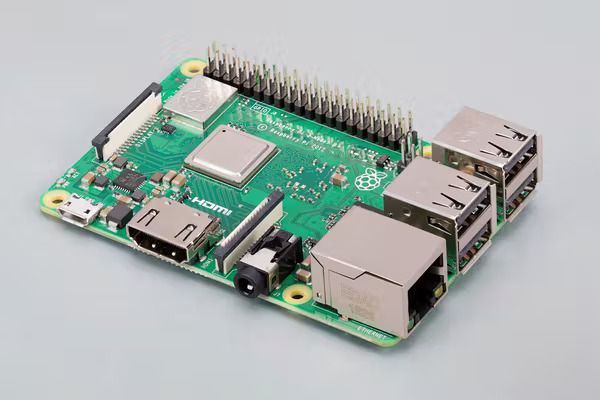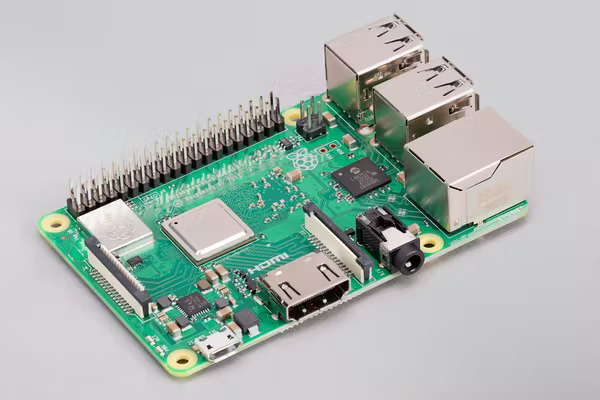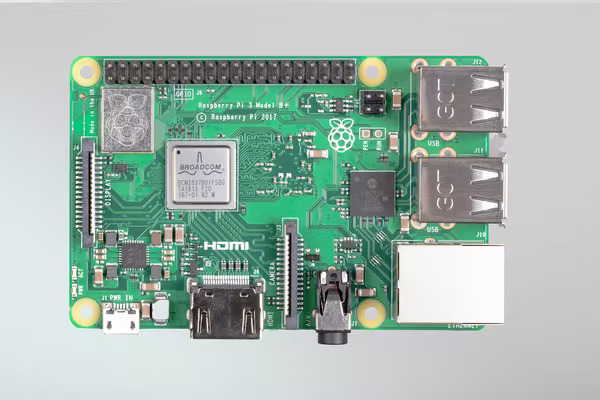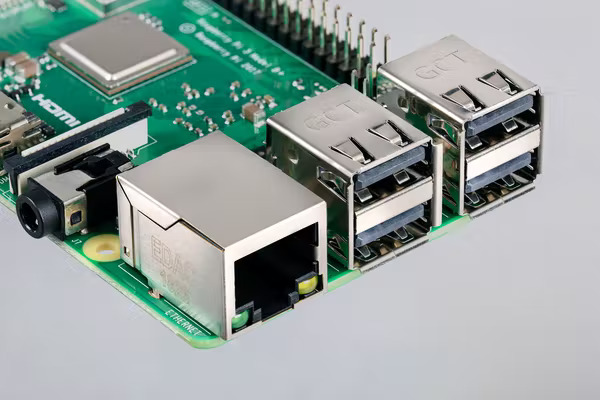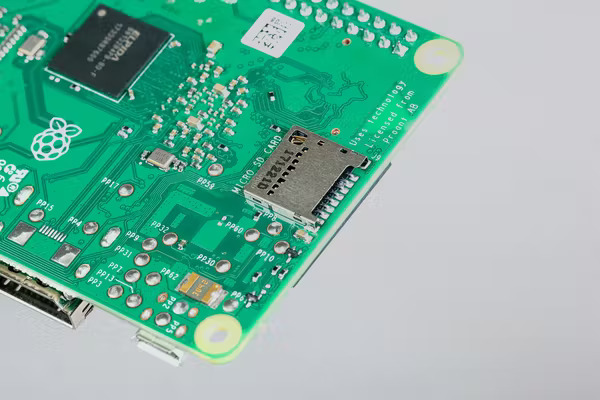1 Raspberry Pi 3 Model B/B+
Contents
1.1 Board Overview
Single-board computer with wireless LAN and Bluetooth connectivity. 1.4 GHz 64-bit quad-core processor, dual-band wireless LAN, Bluetooth 4.2/BLE, faster Ethernet, and Power-over-Ethernet support (with separate PoE HAT).
1.1.1 Photos
1.1.2 Specification
Model |
Raspberry Pi 3 |
|---|---|
Processor |
Broadcom BCM2837B0
4 x Cortex-A53 (ARMv8) 64-bit
frequency up to 1.4 GHz
|
Memory |
1 GiB LPDDR2 SDRAM
|
Storage |
microSD
|
USB |
4 × Type A USB 2.0 Host LS/FS/HS
|
Video |
1 × Full-size HDMI
|
Audio |
1 × 3.5 mm Audio Jack
|
Ethernet |
1 × Gigabit Ethernet over USB 2.0 (maximum throughput 300 Mbps)
|
Wireless |
2.4 GHz and 5 GHz IEEE 802.11.b/g/n/ac wireless LAN
Bluetooth 4.2, BLE
|
Other |
Externded 40-pin GPIO header
CSI camera port for connecting a Raspberry Pi camera
DSI display port for connecting a Raspberry Pi touchscreen display
Power-over-Ethernet (PoE) support (requires separate PoE HAT)
4-pole stereo output and composite video port
|
Power |
5V/2.5A DC |
1.2 Build Targets
1.2.1 Machines
Board[1] |
Target YAML[2] |
Machine[3] |
Target Recipe(s)[4] |
Running Media[5] |
Installation Media[6] |
|---|---|---|---|---|---|
Raspberry Pi 3 Model B/B+ |
|
|
|
microSD card |
– |
1.2.2 Images
Read-Only Root Filesystem Image |
Recipe[7] |
Supported by Target(s) |
Description |
|---|---|---|---|
|
|
All |
Standard TanoWrt image. |
Image recipe name. This name can be used as argument
for --target build command option (see Section 1.3 section).
1.3 Build
Please read the common information on how to perform a TanoWrt images build and preparing the build environment in section “Building TanoWrt”.
See also
See section Section 1.2.1 to select the required target YAML file (
<target-yml>).See section Section 1.2.2 to select the required root filesystem image recipe (
<target-recipe>).See section Section 1.4 for detailed information about the produced build artifacts.
1.3.1 Examples
1.3.1.1 Build Default Images for Raspberry Pi 3 Board
For SD Card
$ kas build targets/kas/rpi3-sd.yml
Default images will be produced to boot and run from the SD card on the Raspberry Pi 3 target board.
1.4 Produced Build Artifacts
All produced build artifacts are stored in the ~/tanowrt/build/tanowrt-glibc/deploy/images/<MACHINE> directory.
Refer to table Produced Build Artifacts for a description of some common (not all) build artifacts.
Artifact |
Target(s) |
Description |
|---|---|---|
Bootloader (U-Boot) |
||
|
All |
U-Boot startup script. |
|
All |
U-Boot initial environment image for microSD card image. |
|
All |
U-Boot binary image for booting from microSD card. |
Linux Kernel and DTB |
||
|
All |
Linux kernel image |
|
All |
Target Device Tree Blobs (DTB). |
|
All |
Target Device Tree Blob overlay files (DTBO). |
Images |
||
|
|
SD card image including all required partitions for booting and running the system. This image is ready to be written to the SD card using the dd utility or similar (see Writing Images). |
Note
<MACHINE> in the artifacts path and artifact file names are replaced by
the actual value of the MACHINE BitBake variable for the chosen
target. <rootfs-image> is replaced
by the actual read-only root filesystem image name.
For example, below is the lists of artifacts produced by the rpi3-sd.yml target build.
There are two types of listings here — a complete listing, and a reduced
listing without the symbolic links and DTBO files display.
Build Artifacts Listings for rpi3-sd.yml Target
[~/tanowrt/build/tanowrt-glibc/deploy/images/rpi3-sd]$ ls -gGh | grep -v -e "dtbo$" | grep -v -e "^l"
total 89M
-rw-r--r-- 2 28K Jul 25 05:08 bcm2710-rpi-3-b-1-5.10.31-tano0.2.7.20.4-rpi3-sd-20220725014408.dtb
-rw-r--r-- 2 29K Jul 25 05:08 bcm2710-rpi-3-b-plus-1-5.10.31-tano0.2.7.20.4-rpi3-sd-20220725014408.dtb
drwxr-xr-x 2 60 Jul 25 05:08 bcm2835-bootfiles
-rw-r--r-- 2 21K Jul 25 05:08 bcm2837-rpi-3-b-1-5.10.31-tano0.2.7.20.4-rpi3-sd-20220725014408.dtb
-rw-r--r-- 2 21K Jul 25 05:08 bcm2837-rpi-3-b-plus-1-5.10.31-tano0.2.7.20.4-rpi3-sd-20220725014408.dtb
drwxr-xr-x 2 440 Jul 25 04:45 bootfiles
-rw-r--r-- 2 263 Jul 25 04:45 boot.scr
-rw-r--r-- 2 33 Jul 25 04:58 fw_env.config-rpi3-sd-2021.01-r0.rpi0
-rw-r--r-- 2 15M Jul 25 05:08 modules-1-5.10.31-tano0.2.7.20.4-rpi3-sd-20220725014408.tgz
-rw-r--r-- 2 6.5K Jul 25 05:11 tanowrt-image-full.env
-rw-r--r-- 2 156K Jul 25 05:10 tanowrt-image-full-rpi3-sd-20220725014408.rootfs.manifest
-rw-r--r-- 2 127M Jul 25 05:11 tanowrt-image-full-rpi3-sd-20220725014408.rootfs.sdcard.img
-rw-r--r-- 2 24 Jul 25 05:11 tanowrt-image-full-rpi3-sd-20220725014408.rootfs.version
-rw-r--r-- 2 343K Jul 25 05:10 tanowrt-image-full-rpi3-sd-20220725014408.testdata.json
-rw-r--r-- 2 3.9K Jul 25 04:58 u-boot-initial-env-rpi3-sd-2021.01-r0.rpi0
-rw-r--r-- 2 485K Jul 25 04:58 u-boot-rpi3-sd-2021.01-r0.rpi0.bin
-rw-r--r-- 2 6.4M Jul 25 05:08 uImage-1-5.10.31-tano0.2.7.20.4-rpi3-sd-20220725014408.bin
[~/tanowrt/build/tanowrt-glibc/deploy/images/rpi3-sd]$ ls -gGh
total 89M
-rw-r--r-- 2 1.6K Jul 25 05:08 at86rf233-1-5.10.31-tano0.2.7.20.4-rpi3-sd-20220725014408.dtbo
lrwxrwxrwx 2 62 Jul 25 05:08 at86rf233.dtbo -> at86rf233-1-5.10.31-tano0.2.7.20.4-rpi3-sd-20220725014408.dtbo
lrwxrwxrwx 2 62 Jul 25 05:08 at86rf233-rpi3-sd.dtbo -> at86rf233-1-5.10.31-tano0.2.7.20.4-rpi3-sd-20220725014408.dtbo
-rw-r--r-- 2 28K Jul 25 05:08 bcm2710-rpi-3-b-1-5.10.31-tano0.2.7.20.4-rpi3-sd-20220725014408.dtb
lrwxrwxrwx 2 67 Jul 25 05:08 bcm2710-rpi-3-b.dtb -> bcm2710-rpi-3-b-1-5.10.31-tano0.2.7.20.4-rpi3-sd-20220725014408.dtb
-rw-r--r-- 2 29K Jul 25 05:08 bcm2710-rpi-3-b-plus-1-5.10.31-tano0.2.7.20.4-rpi3-sd-20220725014408.dtb
lrwxrwxrwx 2 72 Jul 25 05:08 bcm2710-rpi-3-b-plus.dtb -> bcm2710-rpi-3-b-plus-1-5.10.31-tano0.2.7.20.4-rpi3-sd-20220725014408.dtb
lrwxrwxrwx 2 72 Jul 25 05:08 bcm2710-rpi-3-b-plus-rpi3-sd.dtb -> bcm2710-rpi-3-b-plus-1-5.10.31-tano0.2.7.20.4-rpi3-sd-20220725014408.dtb
lrwxrwxrwx 2 67 Jul 25 05:08 bcm2710-rpi-3-b-rpi3-sd.dtb -> bcm2710-rpi-3-b-1-5.10.31-tano0.2.7.20.4-rpi3-sd-20220725014408.dtb
drwxr-xr-x 2 60 Jul 25 05:08 bcm2835-bootfiles
-rw-r--r-- 2 21K Jul 25 05:08 bcm2837-rpi-3-b-1-5.10.31-tano0.2.7.20.4-rpi3-sd-20220725014408.dtb
lrwxrwxrwx 2 67 Jul 25 05:08 bcm2837-rpi-3-b.dtb -> bcm2837-rpi-3-b-1-5.10.31-tano0.2.7.20.4-rpi3-sd-20220725014408.dtb
-rw-r--r-- 2 21K Jul 25 05:08 bcm2837-rpi-3-b-plus-1-5.10.31-tano0.2.7.20.4-rpi3-sd-20220725014408.dtb
lrwxrwxrwx 2 72 Jul 25 05:08 bcm2837-rpi-3-b-plus.dtb -> bcm2837-rpi-3-b-plus-1-5.10.31-tano0.2.7.20.4-rpi3-sd-20220725014408.dtb
lrwxrwxrwx 2 72 Jul 25 05:08 bcm2837-rpi-3-b-plus-rpi3-sd.dtb -> bcm2837-rpi-3-b-plus-1-5.10.31-tano0.2.7.20.4-rpi3-sd-20220725014408.dtb
lrwxrwxrwx 2 67 Jul 25 05:08 bcm2837-rpi-3-b-rpi3-sd.dtb -> bcm2837-rpi-3-b-1-5.10.31-tano0.2.7.20.4-rpi3-sd-20220725014408.dtb
drwxr-xr-x 2 440 Jul 25 04:45 bootfiles
-rw-r--r-- 2 263 Jul 25 04:45 boot.scr
-rw-r--r-- 2 1.1K Jul 25 05:08 disable-bt-1-5.10.31-tano0.2.7.20.4-rpi3-sd-20220725014408.dtbo
lrwxrwxrwx 2 63 Jul 25 05:08 disable-bt.dtbo -> disable-bt-1-5.10.31-tano0.2.7.20.4-rpi3-sd-20220725014408.dtbo
lrwxrwxrwx 2 63 Jul 25 05:08 disable-bt-rpi3-sd.dtbo -> disable-bt-1-5.10.31-tano0.2.7.20.4-rpi3-sd-20220725014408.dtbo
-rw-r--r-- 2 801 Jul 25 05:08 dwc2-1-5.10.31-tano0.2.7.20.4-rpi3-sd-20220725014408.dtbo
lrwxrwxrwx 2 57 Jul 25 05:08 dwc2.dtbo -> dwc2-1-5.10.31-tano0.2.7.20.4-rpi3-sd-20220725014408.dtbo
lrwxrwxrwx 2 57 Jul 25 05:08 dwc2-rpi3-sd.dtbo -> dwc2-1-5.10.31-tano0.2.7.20.4-rpi3-sd-20220725014408.dtbo
lrwxrwxrwx 2 37 Jul 25 04:58 fw_env.config -> fw_env.config-rpi3-sd-2021.01-r0.rpi0
lrwxrwxrwx 2 37 Jul 25 04:58 fw_env.config-rpi3-sd -> fw_env.config-rpi3-sd-2021.01-r0.rpi0
-rw-r--r-- 2 33 Jul 25 04:58 fw_env.config-rpi3-sd-2021.01-r0.rpi0
-rw-r--r-- 2 1.3K Jul 25 05:08 gpio-ir-1-5.10.31-tano0.2.7.20.4-rpi3-sd-20220725014408.dtbo
lrwxrwxrwx 2 60 Jul 25 05:08 gpio-ir.dtbo -> gpio-ir-1-5.10.31-tano0.2.7.20.4-rpi3-sd-20220725014408.dtbo
lrwxrwxrwx 2 60 Jul 25 05:08 gpio-ir-rpi3-sd.dtbo -> gpio-ir-1-5.10.31-tano0.2.7.20.4-rpi3-sd-20220725014408.dtbo
-rw-r--r-- 2 1.3K Jul 25 05:08 gpio-ir-1-5.10.31-tano0.2.7.20.4-rpi3-sd-20220725014408.dtbo
lrwxrwxrwx 2 60 Jul 25 05:08 gpio-ir.dtbo -> gpio-ir-1-5.10.31-tano0.2.7.20.4-rpi3-sd-20220725014408.dtbo
lrwxrwxrwx 2 60 Jul 25 05:08 gpio-ir-rpi3-sd.dtbo -> gpio-ir-1-5.10.31-tano0.2.7.20.4-rpi3-sd-20220725014408.dtbo
-rw-r--r-- 2 1.1K Jul 25 05:08 gpio-ir-tx-1-5.10.31-tano0.2.7.20.4-rpi3-sd-20220725014408.dtbo
lrwxrwxrwx 2 63 Jul 25 05:08 gpio-ir-tx.dtbo -> gpio-ir-tx-1-5.10.31-tano0.2.7.20.4-rpi3-sd-20220725014408.dtbo
lrwxrwxrwx 2 63 Jul 25 05:08 gpio-ir-tx-rpi3-sd.dtbo -> gpio-ir-tx-1-5.10.31-tano0.2.7.20.4-rpi3-sd-20220725014408.dtbo
-rw-r--r-- 2 1.4K Jul 25 05:08 gpio-key-1-5.10.31-tano0.2.7.20.4-rpi3-sd-20220725014408.dtbo
lrwxrwxrwx 2 61 Jul 25 05:08 gpio-key.dtbo -> gpio-key-1-5.10.31-tano0.2.7.20.4-rpi3-sd-20220725014408.dtbo
lrwxrwxrwx 2 61 Jul 25 05:08 gpio-key-rpi3-sd.dtbo -> gpio-key-1-5.10.31-tano0.2.7.20.4-rpi3-sd-20220725014408.dtbo
-rw-r--r-- 2 779 Jul 25 05:08 hifiberry-amp-1-5.10.31-tano0.2.7.20.4-rpi3-sd-20220725014408.dtbo
lrwxrwxrwx 2 66 Jul 25 05:08 hifiberry-amp.dtbo -> hifiberry-amp-1-5.10.31-tano0.2.7.20.4-rpi3-sd-20220725014408.dtbo
lrwxrwxrwx 2 66 Jul 25 05:08 hifiberry-amp-rpi3-sd.dtbo -> hifiberry-amp-1-5.10.31-tano0.2.7.20.4-rpi3-sd-20220725014408.dtbo
-rw-r--r-- 2 655 Jul 25 05:08 hifiberry-dac-1-5.10.31-tano0.2.7.20.4-rpi3-sd-20220725014408.dtbo
lrwxrwxrwx 2 66 Jul 25 05:08 hifiberry-dac.dtbo -> hifiberry-dac-1-5.10.31-tano0.2.7.20.4-rpi3-sd-20220725014408.dtbo
-rw-r--r-- 2 1.9K Jul 25 05:08 hifiberry-dacplus-1-5.10.31-tano0.2.7.20.4-rpi3-sd-20220725014408.dtbo
lrwxrwxrwx 2 70 Jul 25 05:08 hifiberry-dacplus.dtbo -> hifiberry-dacplus-1-5.10.31-tano0.2.7.20.4-rpi3-sd-20220725014408.dtbo
lrwxrwxrwx 2 70 Jul 25 05:08 hifiberry-dacplus-rpi3-sd.dtbo -> hifiberry-dacplus-1-5.10.31-tano0.2.7.20.4-rpi3-sd-20220725014408.dtbo
lrwxrwxrwx 2 66 Jul 25 05:08 hifiberry-dac-rpi3-sd.dtbo -> hifiberry-dac-1-5.10.31-tano0.2.7.20.4-rpi3-sd-20220725014408.dtbo
-rw-r--r-- 2 959 Jul 25 05:08 hifiberry-digi-1-5.10.31-tano0.2.7.20.4-rpi3-sd-20220725014408.dtbo
lrwxrwxrwx 2 67 Jul 25 05:08 hifiberry-digi.dtbo -> hifiberry-digi-1-5.10.31-tano0.2.7.20.4-rpi3-sd-20220725014408.dtbo
lrwxrwxrwx 2 67 Jul 25 05:08 hifiberry-digi-rpi3-sd.dtbo -> hifiberry-digi-1-5.10.31-tano0.2.7.20.4-rpi3-sd-20220725014408.dtbo
-rw-r--r-- 2 6.4K Jul 25 05:08 i2c-rtc-1-5.10.31-tano0.2.7.20.4-rpi3-sd-20220725014408.dtbo
lrwxrwxrwx 2 60 Jul 25 05:08 i2c-rtc.dtbo -> i2c-rtc-1-5.10.31-tano0.2.7.20.4-rpi3-sd-20220725014408.dtbo
lrwxrwxrwx 2 60 Jul 25 05:08 i2c-rtc-rpi3-sd.dtbo -> i2c-rtc-1-5.10.31-tano0.2.7.20.4-rpi3-sd-20220725014408.dtbo
-rw-r--r-- 2 1.3K Jul 25 05:08 iqaudio-dac-1-5.10.31-tano0.2.7.20.4-rpi3-sd-20220725014408.dtbo
lrwxrwxrwx 2 64 Jul 25 05:08 iqaudio-dac.dtbo -> iqaudio-dac-1-5.10.31-tano0.2.7.20.4-rpi3-sd-20220725014408.dtbo
-rw-r--r-- 2 1.5K Jul 25 05:08 iqaudio-dacplus-1-5.10.31-tano0.2.7.20.4-rpi3-sd-20220725014408.dtbo
lrwxrwxrwx 2 68 Jul 25 05:08 iqaudio-dacplus.dtbo -> iqaudio-dacplus-1-5.10.31-tano0.2.7.20.4-rpi3-sd-20220725014408.dtbo
lrwxrwxrwx 2 68 Jul 25 05:08 iqaudio-dacplus-rpi3-sd.dtbo -> iqaudio-dacplus-1-5.10.31-tano0.2.7.20.4-rpi3-sd-20220725014408.dtbo
lrwxrwxrwx 2 64 Jul 25 05:08 iqaudio-dac-rpi3-sd.dtbo -> iqaudio-dac-1-5.10.31-tano0.2.7.20.4-rpi3-sd-20220725014408.dtbo
-rw-r--r-- 2 1.8K Jul 25 05:08 mcp2515-can0-1-5.10.31-tano0.2.7.20.4-rpi3-sd-20220725014408.dtbo
lrwxrwxrwx 2 65 Jul 25 05:08 mcp2515-can0.dtbo -> mcp2515-can0-1-5.10.31-tano0.2.7.20.4-rpi3-sd-20220725014408.dtbo
lrwxrwxrwx 2 65 Jul 25 05:08 mcp2515-can0-rpi3-sd.dtbo -> mcp2515-can0-1-5.10.31-tano0.2.7.20.4-rpi3-sd-20220725014408.dtbo
-rw-r--r-- 2 1.8K Jul 25 05:08 miniuart-bt-1-5.10.31-tano0.2.7.20.4-rpi3-sd-20220725014408.dtbo
lrwxrwxrwx 2 64 Jul 25 05:08 miniuart-bt.dtbo -> miniuart-bt-1-5.10.31-tano0.2.7.20.4-rpi3-sd-20220725014408.dtbo
lrwxrwxrwx 2 64 Jul 25 05:08 miniuart-bt-rpi3-sd.dtbo -> miniuart-bt-1-5.10.31-tano0.2.7.20.4-rpi3-sd-20220725014408.dtbo
-rw-r--r-- 2 15M Jul 25 05:08 modules-1-5.10.31-tano0.2.7.20.4-rpi3-sd-20220725014408.tgz
lrwxrwxrwx 2 59 Jul 25 05:08 modules-rpi3-sd.tgz -> modules-1-5.10.31-tano0.2.7.20.4-rpi3-sd-20220725014408.tgz
-rw-r--r-- 2 1.5K Jul 25 05:08 pitft22-1-5.10.31-tano0.2.7.20.4-rpi3-sd-20220725014408.dtbo
lrwxrwxrwx 2 60 Jul 25 05:08 pitft22.dtbo -> pitft22-1-5.10.31-tano0.2.7.20.4-rpi3-sd-20220725014408.dtbo
lrwxrwxrwx 2 60 Jul 25 05:08 pitft22-rpi3-sd.dtbo -> pitft22-1-5.10.31-tano0.2.7.20.4-rpi3-sd-20220725014408.dtbo
-rw-r--r-- 2 2.4K Jul 25 05:08 pitft28-capacitive-1-5.10.31-tano0.2.7.20.4-rpi3-sd-20220725014408.dtbo
lrwxrwxrwx 2 71 Jul 25 05:08 pitft28-capacitive.dtbo -> pitft28-capacitive-1-5.10.31-tano0.2.7.20.4-rpi3-sd-20220725014408.dtbo
lrwxrwxrwx 2 71 Jul 25 05:08 pitft28-capacitive-rpi3-sd.dtbo -> pitft28-capacitive-1-5.10.31-tano0.2.7.20.4-rpi3-sd-20220725014408.dtbo
-rw-r--r-- 2 2.7K Jul 25 05:08 pitft28-resistive-1-5.10.31-tano0.2.7.20.4-rpi3-sd-20220725014408.dtbo
lrwxrwxrwx 2 70 Jul 25 05:08 pitft28-resistive.dtbo -> pitft28-resistive-1-5.10.31-tano0.2.7.20.4-rpi3-sd-20220725014408.dtbo
lrwxrwxrwx 2 70 Jul 25 05:08 pitft28-resistive-rpi3-sd.dtbo -> pitft28-resistive-1-5.10.31-tano0.2.7.20.4-rpi3-sd-20220725014408.dtbo
-rw-r--r-- 2 2.8K Jul 25 05:08 pitft35-resistive-1-5.10.31-tano0.2.7.20.4-rpi3-sd-20220725014408.dtbo
lrwxrwxrwx 2 70 Jul 25 05:08 pitft35-resistive.dtbo -> pitft35-resistive-1-5.10.31-tano0.2.7.20.4-rpi3-sd-20220725014408.dtbo
lrwxrwxrwx 2 70 Jul 25 05:08 pitft35-resistive-rpi3-sd.dtbo -> pitft35-resistive-1-5.10.31-tano0.2.7.20.4-rpi3-sd-20220725014408.dtbo
-rw-r--r-- 2 1.2K Jul 25 05:08 pps-gpio-1-5.10.31-tano0.2.7.20.4-rpi3-sd-20220725014408.dtbo
lrwxrwxrwx 2 61 Jul 25 05:08 pps-gpio.dtbo -> pps-gpio-1-5.10.31-tano0.2.7.20.4-rpi3-sd-20220725014408.dtbo
lrwxrwxrwx 2 61 Jul 25 05:08 pps-gpio-rpi3-sd.dtbo -> pps-gpio-1-5.10.31-tano0.2.7.20.4-rpi3-sd-20220725014408.dtbo
-rw-r--r-- 2 842 Jul 25 05:08 rpi-ft5406-1-5.10.31-tano0.2.7.20.4-rpi3-sd-20220725014408.dtbo
lrwxrwxrwx 2 63 Jul 25 05:08 rpi-ft5406.dtbo -> rpi-ft5406-1-5.10.31-tano0.2.7.20.4-rpi3-sd-20220725014408.dtbo
lrwxrwxrwx 2 63 Jul 25 05:08 rpi-ft5406-rpi3-sd.dtbo -> rpi-ft5406-1-5.10.31-tano0.2.7.20.4-rpi3-sd-20220725014408.dtbo
-rw-r--r-- 2 2.9K Jul 25 05:08 rpi-poe-1-5.10.31-tano0.2.7.20.4-rpi3-sd-20220725014408.dtbo
lrwxrwxrwx 2 60 Jul 25 05:08 rpi-poe.dtbo -> rpi-poe-1-5.10.31-tano0.2.7.20.4-rpi3-sd-20220725014408.dtbo
lrwxrwxrwx 2 60 Jul 25 05:08 rpi-poe-rpi3-sd.dtbo -> rpi-poe-1-5.10.31-tano0.2.7.20.4-rpi3-sd-20220725014408.dtbo
-rw-r--r-- 2 6.5K Jul 25 05:11 tanowrt-image-full.env
-rw-r--r-- 2 156K Jul 25 05:10 tanowrt-image-full-rpi3-sd-20220725014408.rootfs.manifest
-rw-r--r-- 2 127M Jul 25 05:11 tanowrt-image-full-rpi3-sd-20220725014408.rootfs.sdcard.img
-rw-r--r-- 2 24 Jul 25 05:11 tanowrt-image-full-rpi3-sd-20220725014408.rootfs.version
-rw-r--r-- 2 343K Jul 25 05:10 tanowrt-image-full-rpi3-sd-20220725014408.testdata.json
lrwxrwxrwx 2 57 Jul 25 05:10 tanowrt-image-full-rpi3-sd.manifest -> tanowrt-image-full-rpi3-sd-20220725014408.rootfs.manifest
lrwxrwxrwx 2 59 Jul 25 05:11 tanowrt-image-full-rpi3-sd.sdcard.img -> tanowrt-image-full-rpi3-sd-20220725014408.rootfs.sdcard.img
lrwxrwxrwx 2 55 Jul 25 05:10 tanowrt-image-full-rpi3-sd.testdata.json -> tanowrt-image-full-rpi3-sd-20220725014408.testdata.json
lrwxrwxrwx 2 56 Jul 25 05:11 tanowrt-image-full-rpi3-sd.version -> tanowrt-image-full-rpi3-sd-20220725014408.rootfs.version
lrwxrwxrwx 2 34 Jul 25 04:58 u-boot.bin -> u-boot-rpi3-sd-2021.01-r0.rpi0.bin
lrwxrwxrwx 2 42 Jul 25 04:58 u-boot-initial-env -> u-boot-initial-env-rpi3-sd-2021.01-r0.rpi0
lrwxrwxrwx 2 42 Jul 25 04:58 u-boot-initial-env-rpi3-sd -> u-boot-initial-env-rpi3-sd-2021.01-r0.rpi0
-rw-r--r-- 2 3.9K Jul 25 04:58 u-boot-initial-env-rpi3-sd-2021.01-r0.rpi0
-rw-r--r-- 2 485K Jul 25 04:58 u-boot-rpi3-sd-2021.01-r0.rpi0.bin
lrwxrwxrwx 2 34 Jul 25 04:58 u-boot-rpi3-sd.bin -> u-boot-rpi3-sd-2021.01-r0.rpi0.bin
lrwxrwxrwx 2 58 Jul 25 05:08 uImage -> uImage-1-5.10.31-tano0.2.7.20.4-rpi3-sd-20220725014408.bin
-rw-r--r-- 2 6.4M Jul 25 05:08 uImage-1-5.10.31-tano0.2.7.20.4-rpi3-sd-20220725014408.bin
lrwxrwxrwx 2 58 Jul 25 05:08 uImage-rpi3-sd.bin -> uImage-1-5.10.31-tano0.2.7.20.4-rpi3-sd-20220725014408.bin
-rw-r--r-- 2 1.5K Jul 25 05:08 vc4-fkms-v3d-1-5.10.31-tano0.2.7.20.4-rpi3-sd-20220725014408.dtbo
lrwxrwxrwx 2 65 Jul 25 05:08 vc4-fkms-v3d.dtbo -> vc4-fkms-v3d-1-5.10.31-tano0.2.7.20.4-rpi3-sd-20220725014408.dtbo
lrwxrwxrwx 2 65 Jul 25 05:08 vc4-fkms-v3d-rpi3-sd.dtbo -> vc4-fkms-v3d-1-5.10.31-tano0.2.7.20.4-rpi3-sd-20220725014408.dtbo
-rw-r--r-- 2 2.7K Jul 25 05:08 vc4-kms-v3d-1-5.10.31-tano0.2.7.20.4-rpi3-sd-20220725014408.dtbo
lrwxrwxrwx 2 64 Jul 25 05:08 vc4-kms-v3d.dtbo -> vc4-kms-v3d-1-5.10.31-tano0.2.7.20.4-rpi3-sd-20220725014408.dtbo
lrwxrwxrwx 2 64 Jul 25 05:08 vc4-kms-v3d-rpi3-sd.dtbo -> vc4-kms-v3d-1-5.10.31-tano0.2.7.20.4-rpi3-sd-20220725014408.dtbo
-rw-r--r-- 2 1.1K Jul 25 05:08 w1-gpio-1-5.10.31-tano0.2.7.20.4-rpi3-sd-20220725014408.dtbo
lrwxrwxrwx 2 60 Jul 25 05:08 w1-gpio.dtbo -> w1-gpio-1-5.10.31-tano0.2.7.20.4-rpi3-sd-20220725014408.dtbo
-rw-r--r-- 2 1.2K Jul 25 05:08 w1-gpio-pullup-1-5.10.31-tano0.2.7.20.4-rpi3-sd-20220725014408.dtbo
lrwxrwxrwx 2 67 Jul 25 05:08 w1-gpio-pullup.dtbo -> w1-gpio-pullup-1-5.10.31-tano0.2.7.20.4-rpi3-sd-20220725014408.dtbo
lrwxrwxrwx 2 67 Jul 25 05:08 w1-gpio-pullup-rpi3-sd.dtbo -> w1-gpio-pullup-1-5.10.31-tano0.2.7.20.4-rpi3-sd-20220725014408.dtbo
lrwxrwxrwx 2 60 Jul 25 05:08 w1-gpio-rpi3-sd.dtbo -> w1-gpio-1-5.10.31-tano0.2.7.20.4-rpi3-sd-20220725014408.dtbo
1.5 Writing Images
1.5.1 Writing Image to SD Card
No special information about writing images to microSD card for Raspberry Pi 3 board. See common instructions in Writing Images to SD Card or USB Flash Drive section.
Examples
Writing bootable image for the rpi3-sd.yml target to the microSD
card /dev/mmcblk1:
$ dd if=tanowrt-image-full-rpi3-sd.sdcard.img of=/dev/mmcblk1
1.6 Booting and Running
1.6.1 Booting from microSD Card
Insert the microSD card into the slot on the Raspberry Pi 3 board (power is off).
Power on board.
TanoWrt will be booting from microSD card.
Log in to system using default credentials.
1.7 Serial Console
Attention
There is no serial port on Raspberry Pi 3 boards
1.8 Default Network Configuration
By default Ethernet port (eth0 interface) are joined into a bridge
(br-lan interface). Bridge (br-lan) configured with static IP address 192.168.0.1/24 with
enabled DHCP server.
The Ethernet port (eth0) has enabled LLDP by default.
1.9 Firmware Upgrade
Attention
Currently, the firmware upgrading for the Raspberry Pi 3 boards is not supported.
